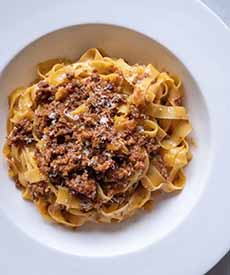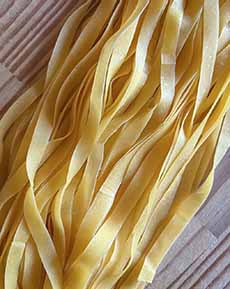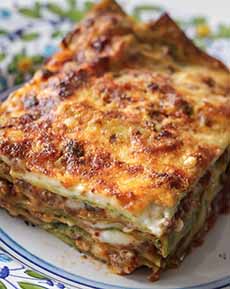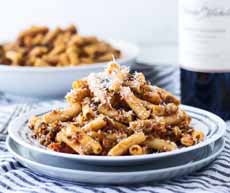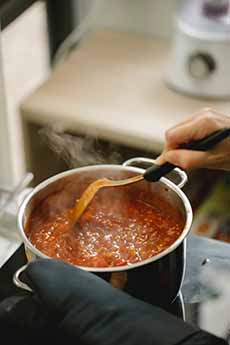What’s A Ragù? It’s World Bolognese Ragù Day!
|
|
What’s a ragù? If you don’t know, it’s time to learn, because October 21st is World Bolognese Ragù Day. A ragù (rah-GOO) is a meat-based sauce. The Italian word derives from the French ragoût, from the verb ragoûter, “to revive the taste.” The French ragout is a simmered stew of fish, meat, or vegetables reduced to small pieces, which became popular in the 18th century [source 1] [source 2]. > The history of ragu is below. But for starters, the earliest documented recipe for a ragù served with pasta comes from the late 18th century in Imola, a commune in the Metropolitan City of Bologna, the historic capital of the Emilia-Romagna region of Italy. The chef, Alberto Alvisi, was the cook to Cardinal Barnaba Chiaramonti, who became Pope Pius VII. A ragù is usually made by adding meat to a soffritto*, a mixture of finely chopped onions, celery, carrots, and garlic, and fresh herbs such as parsley or sage. The soffritto is partially cooked in olive oil. It is then simmered for a long time in tomato sauce. (A soffritto is the progenitor of the French concept of the mirepoix, onions, celery, and carrots cooked slowly in butter or olive oil.) Ragù can be made with any meat or game. Which brings us to today’s food holiday: Ragù alla bolognese (often called Bolognese sauce in the U.S.) is made with ground pork, beef, and pancetta. An authentic ragù alla Bolognese is not a tomato sauce with meat, but a meat sauce with a smaller amount of tomato. Ragù alla Napoletana (Neapolitan ragù) includes sliced beef, raisins, and pine nuts. There are many other types of ragù, each city adding its own touches: Here is a recipe with many tips from Tina’s Table, whose creator, Tina Prestia, advises that it takes five hours to make an authentic Bolognese. Check out photo #1, the real deal, her ragu alla Bolognese served atop tagliatelle, which is the “official pasta” for the ragù. Although in Italy ragù alla bolognese is served with flat pasta, like tagliatelle, a “Spaghetti Bolognese” using round strands of spaghetti has become a popular dish in many other parts of the world. Here’s another recipe, this one is the “official” recipe registered with the Bologna Chamber of Commerce in 1982. It’s in Italian, but Google Translate will translate it for you. Italian-American Bolognese is not the same as Bolognese from Emilia-Romagna, in northern Italy. In Emilia-Romagna, Bolognese is as much about the aromatic base of vegetables as it is about the meat. Italian-American versions are very meat-heavy, benefiting from America’s much more affordable meat supply. It’s more of a tomato sauce with ground beef. Red wine is also used, instead of the white wine of Italian Bolognese. Bolognese is a form of ragù. There are some technicalities: The first sauce called a ragù, ragù per i maccheroni (ragu for pasta**), was recorded by Alberto Alvisi, the cook to the Cardinal Barnaba Chiaramonti of Imola, who became Pope Pius VII. It’s thought to derive from the mid-19th century when Alvisi spent considerable time in Bologna. |
|
|
The word ragù had reached the region of Emilia-Romagna from France (from ragoût) in the late 18th century. Some historians note that this followed Napoleon’s 1796 invasion and occupation of the northern regions of Italy. Alvisi was inspired by French ragoût, which became popular in Italy when Napoleon’s soldiers brought it with them. Wealthy and aristocratic Italians were attracted to French culture and food and readily incorporated classic French dishes like ragoût in their own culinary traditions. Alvisi’s sauce called for predominantly lean veal along with pancetta, butter, onion, and carrot. The meats and vegetables were finely minced, cooked with butter until the meats browned, then covered and cooked with broth. There was no tomato, either in paste form or otherwise. His recipe was published as Il Ragù del Cardinale (“The Cardinal’s Ragù”). Here’s the recipe. The late 1800s. By the late 19th century, the high cost of meat led to dishes that needed a lot of it reserved for feast days and Sundays—and only among the wealthier classes of the newly unified Italy [source]. Pasta was not part of the “cucina povera” of Italy—the food is eaten by peasants and other poor. Farmers mostly consumed porridge-like soups, different types of breads and grains, and a lot of the vegetables they grew and foraged. White flour was expensive. Technological advances of the Industrial Revolution at the end of the 19th century made white flour more affordable for the less affluent. The adoption of pasta by lower-income people was furthered in the period of economic prosperity that followed World War II. According to De Vita, before World War II, 80% of the Italian rural population ate a diet based on plants; pasta was reserved for special feast days and was then often served in a legume soup. *The Italian spelling is soffritto, the Spanish spelling is sofrito. **At the time, maccheroni was a general term for both dried and fresh pasta. †Rigatoni is also known as denti di cavallo, which translates to “horse’s teeth.” This cut has ridges that help to pick up and hold the sauce. CHECK OUT WHAT’S HAPPENING ON OUR HOME PAGE, THENIBBLE.COM.
|
||
